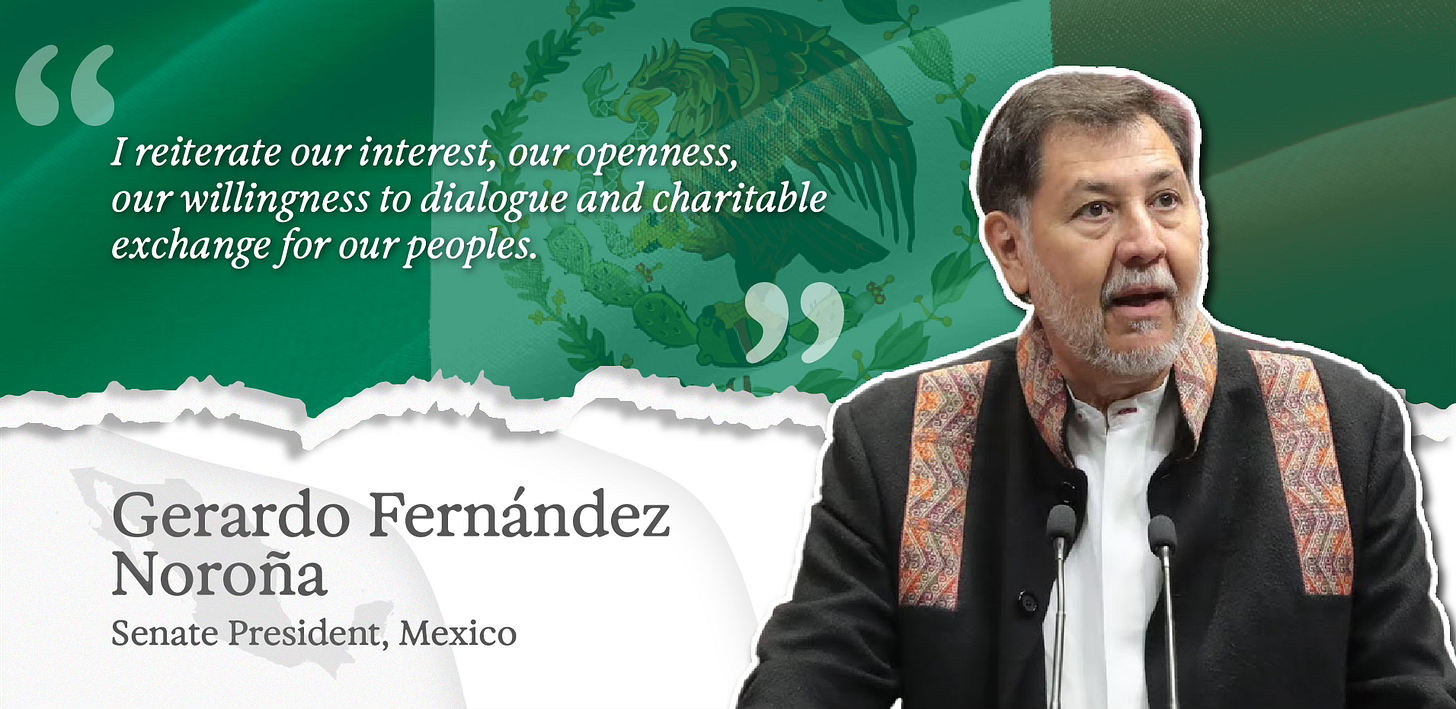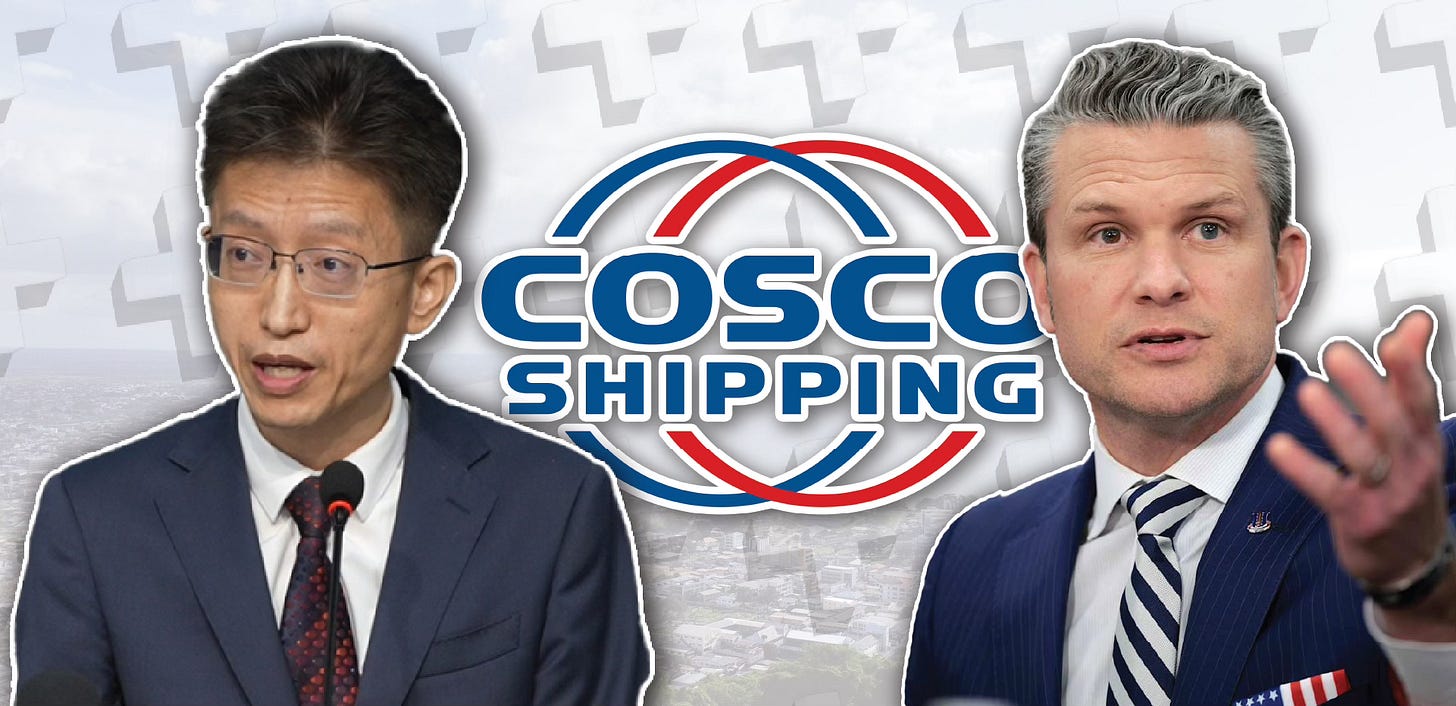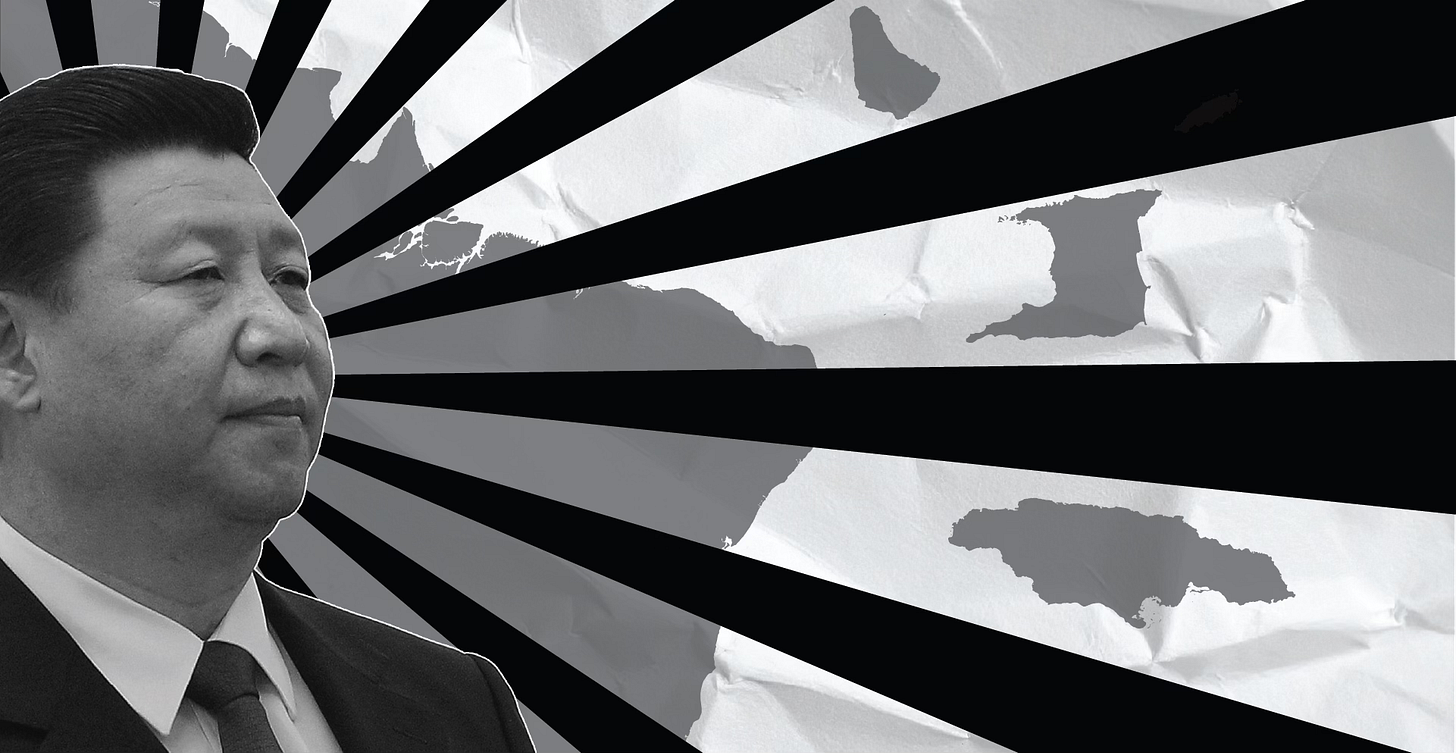Charitable Exchanges
Guyana's China frustrations, Beijing prepares for China-CELAC ministerial, and new South America infrastructure. Plus: Mapping MOFA's LAC leaders
Welcome to Chaufa, a China-Western Hemisphere Newsletter by CPSI.
Today’s edition covers April 7 to April 20
Listen on Spotify
The Top 5 Stories:
Guyana’s Foreign Ministry rebuked China’s Chargé d’Affaires, Huang Rui, after he offered that Guyana and Venezuela should resolve Caracas’ aggression against Guyana through “friendly consultations and negotiations.” He also noted that Beijing “never intervenes in the internal affairs of other countries.” In response, the Guyanese foreign ministry said that China “needs to be principled in its position to respect Guyana's territorial integrity and not to appease Nicolas Maduro's serial violation of international law.”
China is among the largest investors in Guyana at the moment, including in the country’s booming oil sector. That said, these tensions are a long time coming, as China has long sought to maintain its deep ties with Caracas at the same time as building its relationship with Georgetown, and it has recently been frustrated by Washington’s insistence on competing with Beijing in the Caribbean nation.
A Chinese delegation led by Qu Yuhui (the Foreign Ministry’s Deputy Director-General for Latin American and Caribbean Affairs) attended the CELAC summit in Honduras and met with at least 15 delegations1 on the sidelines to prepare for the China-CELAC ministerial in the PRC on May 13. President Xi also sent a message of congratulations to the gathering, noting that a “century-old transformation that is accelerating” with the Global South "growing strongly.” (TeleSur) Later, Colombian President Petro (who took over CELAC’s President Pro Tempore role) talked over potential deliverables from the upcoming China-CELAC summit with the Chinese ambassador.
China’s Special Representative for Latin America, Qiu Xiaoqi, also traveled to Honduras, meeting with the old CELAC host, Honduras, and new host, Colombia. Later, he traveled to the Dominican Republic and Costa Rica.
Altogether, these developments show how China is building on over a decade of diplomatic work to shrewdly take advantage of the discontent fostered by the Trump Administration’s aggressive policy towards the region. May’s China-CELAC ministerial should be closely watched for new initiatives or projects that could further diversify the region away from the United States.
U.S. tariffs on Chinese goods, as well as fees on Chinese-built ships, are concerning business and government leaders in the Caribbean. A senior Bahamas hospitality business leader warned that the move could negatively impact both cruise ship tourism and food imports, since the country is dependent on the United States for 70% of its foodstuffs. Relatedly, a company in Trinidad and Tobago said that it would have to raise prices on feminine products due to tariffs, while an economist in Dominica and the Chamber of Commerce in Antigua and Barbuda cautioned about how tariff-induced price increases will be passed on to consumers. That said, policymakers in other countries like Jamaica said that they do not expect any negative repercussions from U.S. trade actions, at least for now.
The U.S. Trade Representative recently announced its plan to charge a fee on shipping fleets that own Chinese ships. However, after successful Caribbean lobbying, the policy will exempt owners of vessels servicing the Caribbean and U.S. territories. Still, the policy will “levy fees based on net tonnage or each container unloaded” and, along with U.S. tariffs on a variety of goods, could still raise prices for both U.S. and foreign consumers.
Chinese company Tianji International proposed a $500 million investment for a port in the southern Peruvian city of Tacna. The proposal would improve existing infrastructure to strengthen the region’s logistics. Meanwhile, a delegation from China State Railway Group traveled to Brazil in a bid to restart the “Central Bi-Oceanic Railway Corridor” from Brazil to Peru
The Tacna port proposal comes right after the Chinese firm COSCO opened the controversial mega-port at Chancay, which has recently come under scrutiny from Peruvian regulators. Despite the controversy and scrutiny, the Chancay port is currently in operation and would be an essential part of any bi-oceanic trade corridor.
During a visit to Panama, U.S. Secretary of Defense Hegseth praised the country’s withdrawal from the Belt and Road Initiative and warned that “China will not weaponize [the Panama] canal.” He later claimed that the PRC’s military presence was “too large,” arguing that “Beijing is investing and operating in this region for military advantage and unfair economic gain.” In response, the Chinese embassy accused the United States of blackmailing Panama.
Trump and Hegseth have both tied the administration’s desire to assert more control over the canal to China’s presence in the Central American country. However, the Panamanians have been steadfast in their commitment to retaining sovereign control over the waterway, with President Mulino rejecting Trump’s assertions that he will “reclaim” the canal.
Core Brief
The Shape of China’s LAC Foreign Policy: The Foreign Ministry
Though it’s been a few months since Chinese President Xi last visited Latin America, the region has seen no shortage of visits from Mainland officials. Just in the past two weeks, a special envoy, a senior Chinese Ministry of Foreign Affairs (MOFA) official, and a leader from the State Council (effectively China’s cabinet) traveled to the region.
With all these figures coming and going, what role does China’s foreign ministry play in the PRC’s LAC foreign policy? Who are these leaders, and what do they do? Though the Chinese government will always be a bit of a black box, this article starts a series investigating and mapping the different institutions that shape and implement the PRC’s foreign policy across Latin America and the Caribbean.
China’s Foreign Ministry: A Brief Background
Unlike in other countries, the Chinese foreign ministry is a relatively weak state institution, as it is focused on implementing, rather than designing, China’s foreign policy. A major reason for this is the centralized nature of policy decision-making in the PRC’s party-state regime. Most major foreign policy decisions are decided by the Chinese Communist Party’s (CCP) Central Foreign Affairs Commission, often relegating MOFA to an implementation space.2
At the same time, MOFA’s relatively weak position can also be attributed to its numerous competitors in the foreign policy space: aside from the usual suspects like the commerce ministry and the military, Chinese foreign policy implementation actors include the CCP’s International Liaison Department, numerous provincial and local governments, and the party’s United Front Work Department.
That said, MOFA still plays several important roles in Chinese foreign policy. First, it uniquely runs regular press conferences that communicate the CCP’s thinking on day-to-day foreign policy issues. And like most foreign ministries, MOFA manages the PRC’s embassies and consulates throughout the region, allowing it to take the lead in hosting most meetings in-country and maintaining relationships to government officials and civil society on the ground.
Mapping MOFA’s LAC Policy: Senior Leadership
Given its relatively marginal status in China’s foreign relations, it should be unsurprising that MOFA seems to lack a dedicated Vice or Assistant Minister just for LAC affairs.
That doesn’t mean that those at the top don’t engage with the region; of the seven Vice and Assistant Ministers, Executive Vice Foreign Minister Ma Chaoxu (马朝旭), head spokesman and Vice Minister Hua Chunying (华春莹), and Assistant Minister and head of the Policy Planning Department Miao Deyu (苗得雨) have taken a particular interest in the region.
In just the past few months, Ma greeted the Brazilian Deputy Foreign Minister, while Hua hosted a group of young Latin American scholars and met with a senior Uruguayan diplomat. Miao seems to have responsibilities for regular engagement with locally stationed foreign diplomats, having just met with the Peruvian, Cuban, and Brazilian ambassadors. That said, LAC is just one geographic priority area of many for these policymakers, so it is unlikely that they are too deeply involved in the day-to-day of LAC foreign policy implementation.
Outside of the Vice and Assistant Foreign Ministers, MOFA also has Special Representatives – according to Baidu, these officials “enjoy the treatment as the highest leader of the government or the organization” on their particular issue area. Since 2015, MOFA has had a Special Representative leading the government’s work on LAC affairs, and since 2021 the role has been filled by retired ambassador to Brazil and Mexico Qiu Xiaoqi (邱小琪).
With his lengthy experience and relatively high rank in the CCP (he’s been a member of the Chinese People's Political Consultative Conference), Qiu is probably the most visible member of the PRC’s foreign policy in the region. Aside from his recent regional visits highlighted above, Qiu attends LAC-related events around the PRC, such as the opening ceremony of the China-Latin America Sustainable Food Innovation Forum and a book launch at the Brazilian embassy.
Mapping MOFA’s LAC Policy: The More Junior Leadership
Much of the day-to-day management of MOFA’s LAC policy in Beijing falls into the hands of former Ambassador to Mexico Zhang Run.3 In his 30-year career, Zhang has almost exclusively focused on LAC policy, having served in Venezuela, Chile, and Argentina as well as three stints in the LAC department. Zhang just returned to the Foreign Ministry a few months ago, but he’s already traveled to Cuba and introduced himself to the LAC diplomatic community in Beijing.
Underneath Zhang, the LAC affairs department has three Deputy Director-Generals: Qu Yuhui, Tang Lingyun, and Sun Yi. None of these officials are senior enough yet to have served as ambassadors in the region, but they all certainly have notable language skills and LAC-related experience: Qu worked as a spokesman in Brazil, Tang served in Barcelona and was an alternate observer at the OAS, and Sun was a counselor at the embassy in Buenos Aires.
It's a bit of a black box on who serves under the Deputy DGs, though prior research has suggested that each of the Deputy DGs manages a couple of divisions. In turn, each of these divisions has 4-6 desk officers working on a particular issue or country. Though today these are fairly junior officials, many of the senior leaders started their careers at the bottom rungs of the LAC affairs department, suggesting that one day they too may work as the lead implementers of MOFA’s LAC agenda.

The Roundup
Politics and diplomacy
Zhang Laiming, the PRC State Council’s Deputy Minister of the Development Research Center, discussed the example of China’s economic modernization in Havana with Cuban government and party leaders.
Uruguayan defense officials met with Chinese diplomats and executives from the Chinese company Norinco to discuss possible weapons sales to the country.
The Vice President of Venezuela met with China’s ambassador to review bilateral cooperation on energy, mining, agriculture and advanced technology, as well as special economic zones.
Canadian Prime Minister Carney named China as the country’s greatest security threat in an election debate, specifically criticizing the PRC’s election interference and aggression in Asia. These comments came after Canada’s Privy Council accused Chinese media of pushing false stories about Carney to influence the election.
Even though the United States already has significantly fewer embassies in the Caribbean than China, the New York Times reported that the Trump Administration is planning to close the diplomatic outpost in Grenada.
Beijing congratulated Ecuadorian President Noboa on his re-election, stressing that “under the leadership of Noboa, Ecuador is expected to continue to make significant progress in its economic and social development.”
Investment, finance, and infrastructure
Argentina extended its $5 billion bilateral currency swap with China through 2026 amid its IMF negotiations. It did so despite Washington’s suggestion that it would delay the IMF deal if Buenos Aires continued the agreement with Beijing.
A couple of companies from Yantai City in Shandong Province discussed new “zero-carbon” investments and partnerships with Barbadian schools and businesses at an event hosted by the Association of Barbados-China Friendship (ABCF). The discussions came as China donated another 30 electric buses to the island nation.
The head of the Mexican Senate, Gerardo Fernández Noroña, met with the PRC embassy’s commercial section head to discuss continued commercial ties in the midst of Washington’s increasingly protectionist trade agenda.
Chile’s Minister of Energy, Diego Pardow, agreed to an MOU on clean energy cooperation with the Director of China’s National Energy Administration, Wang Hongzhi.
The PRC’s competitor to Uber, Didi, announced a new $170 million expansion in Brazil to deliver food through a platform called 99Food. (People’s Daily)
Trade and Technology
Nicaraguan President Daniel Ortega welcomed Huawei’s regional president for Latin America to discuss new bilateral cooperation projects, including telecommunications modernization.
In response to the U.S.-China trade war, Chinese oil refiners’ purchases of Canadian crude have soared to more than 7 million barrels a month.
Bolivia officially started exporting chia seeds to China, opening a new market to a growing local industry.
After an initial investigation, Chile froze a joint astronomical project in Antofagasta between the Catholic University of the North and China’s National Astronomical Observatory of China. The project had previously drawn concerns from the United States, and in response, the PRC embassy said that it trusts Chile will hold an “independent position” on the project.
Taiwan
To reduce exposure to the Trump Administration’s tariffs, Taiwanese firms like Foxconn-subsidiary FIH Mobile and auto parts manufacturer Hiroca Holdings are looking to shift production to Mexico.
Taiwan’s International Cooperation and Development Fund signed an agreement with St. Kitts and Nevis for a $13 million loan that will support water security and resilience at the Basseterre Desalination Plant.
President Peña said that Taiwan will donate four helicopters to Paraguay’s military later this summer.
The ROC donated four drug testing kits to the Royal Saint Lucia Police Force to enhance “the RSLPF’s capacity to respond to drug-related offences.”
The St. Kitts and Nevis National Assembly passed a resolution endorsing Taiwan’s engagement in international organizations, while the country’s government issued a statement condemning China’s growing aggression in the Taiwan Strait.
Society and culture
Costa Rica granted asylum to 16 Chinese nationals who had originally been seeking asylum in the United States, marking one of the first times that the Central American country has taken such steps.
The Colombian government eliminated visa requirements for PRC citizens in a bid to boost tourism to the country.
Analysis and Opinion
Chatham House published a podcast featuring Yu Jie, Evan Ellis, and Bruno Binetti on “the growing battle for influence in Latin America between the US and China.”
The Financial Times published a piece on how Brazilian farmers are poised to benefit from the U.S.-China trade war as the PRC switches its soy and beef imports from the United States to the South American country. Meanwhile, the New York Times had a piece of analysis on how a U.S. critical minerals mine in Brazil is reliant on Chinese mineral processing.
The China-Global South Project recently published two notable articles: one by Eric Olander on China’s and Brazil’s ramped-up engagement, and another by Alonso Illueca on “how Panama is now a frontline in the U.S.-China strategic competition.”
That’s it for now, see you again in two weeks!
Make sure you don’t miss the next issue of Chaufa 👇
One source suggested that St. Vincent and the Grenadines, which recognizes Taiwan and not the PRC, unusually met with the delegation.
There is some debate in the academic community about whether (and to what degree) MOFA has space to formulate policy — I tend to believe that MOFA is probably influencing policy on “relatively” minor issues, but for LAC (a comparatively unimportant region for the PRC), these minor issues can be of great importance. Nevertheless, when it comes to major issues (such as the U.S.-China trade war, offering financing in the developing world, or deepening relations with U.S. adversaries like Cuba and Venezuela), MOFA is largely in an execution space.
According to the foreign ministry, the office’s responsibilities are wide-ranging, including “implementing the country's foreign policy; investigating and planning the bilateral relations between China and [Latin America and the Caribbean]; handling relevant diplomatic affairs… guiding and coordinating specific policies, exchanges, and cooperation involving the competent areas and countries; guiding the relevant business of diplomatic institutions abroad; [and] translating important diplomatic activities and non-Chinese documents.” Some policy development is happening at this level, but much of the work lies in coordination and execution.




